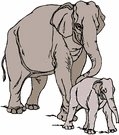
Worksheets and No Prep Teaching Resources
Reading Comprehension Worksheets
Animal Themes
Endangered Animals Theme Unit
Reptiles

Animal Themes
 Worksheets and No Prep Teaching Resources Reading Comprehension Worksheets Animal Themes Endangered Animals Theme Unit Reptiles |
 Animal Themes |
| edHelper's suggested reading level: | grades 4 to 8 | |
| Flesch-Kincaid grade level: | 10.34 |
| Leatherback Turtles |

|
 1 Out in the oceans, there lives the Earth's largest turtle species -- the leatherback turtle. Indeed, its massive measurement -- up to 8 feet in length and 2,000 pounds in weight -- is nearly 3 times longer and 5 times heavier than the first runner-up, the green turtle! Yet, apart from its size, the leatherback turtle is equally famous for many of its rather un-turtle-like features and amazing behaviors.
1 Out in the oceans, there lives the Earth's largest turtle species -- the leatherback turtle. Indeed, its massive measurement -- up to 8 feet in length and 2,000 pounds in weight -- is nearly 3 times longer and 5 times heavier than the first runner-up, the green turtle! Yet, apart from its size, the leatherback turtle is equally famous for many of its rather un-turtle-like features and amazing behaviors. |
Create Weekly Reading Books
Prepare for an entire week at once! |
| Leave your feedback on Leatherback Turtles (use this link if you found an error in the story) |
 |
Animal Themes
|
 |
Endangered Animals Theme Unit
|
 |
Reptiles
|
|
|